Sodalite is often accepted as the so-called “Stone of Logic.” It is an arresting stone made of deep blue streaks with white in between, almost resembling the night sky. Sodalite was believed to have powerful healing and metaphysical properties beyond its appearance. The stone is said to encourage clarity, emotional balance, and communication, making it a favorite among those seeking peace and self-discovery. In this blog post, we will explore the multifaceted nature of sodalite, from its profound spiritual significance to its diverse applications in everyday life. Whether you are a seasoned crystal enthusiast or just starting, this guide will be of great benefit to you regarding how sodalite can bring harmony, creativity, and tranquility into your life.
What is Sodalite?
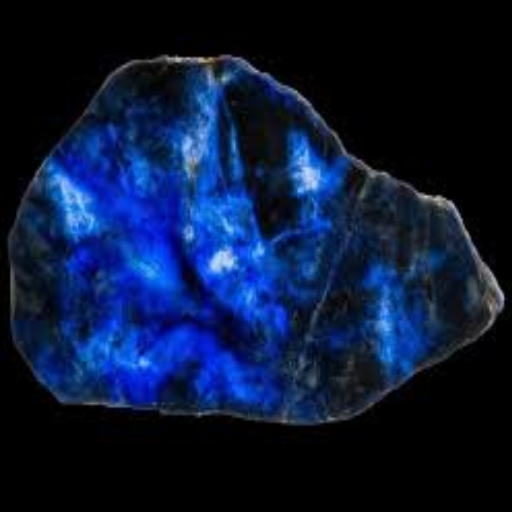
The sodalite is a vibrant blue mineral, the color and type of appearance giving it a look of charm while suggesting calm energy. It is made of sodium, aluminum, and silica; any of these silicates may feature white veining or specks of other minerals, adding to the unique charm of the stone. Sodalite is a stone of clarity that contains energies of balance, often featured in jewelry, decorative home objects, and spiritual works. It seeks to foster self-expression, reason, and emotional harmony in the user, and thus is highly sought after by individuals who seek the dual benefits of beauty and metaphysics.
Definition and Appearance
Sodalite is a particular shade of blue that has many admirers for its beauty and metaphysical properties. It is usually located within igneous rocks. This beautiful blue shade often features white veining or mottled patterns due to calcite inclusions, and this unique set of markings can help identify each stone. A medium hardness of 5.5-6 on the Mohs scale indicates that sodalite remains in good condition during decorative and ornamental use.
Having been discovered in Greenland in 1811, sodalite is now commonly mined in various locations, including Canada, Brazil, Russia, and Namibia. Sodium aluminum silicate with chlorine (Na₈Al₆Si₆O₂₄Cl₂) gives the stone its characteristic brilliant blue color. Cubic crystals characterize the gemstone, but well-formed crystals are comparatively rare compared to the massive form.
Interestingly, in addition to the physical description, the stone is often referred to as a “stone of insight” in holistic terms. Thought to promote rational thinking, emotional balance, and communication, it’s an attractive prospect for anyone seeking clarity and inner harmony. Jewelers and collectors value sodalite not only for its metaphysical properties but also for its striking aesthetic qualities, incorporating it into various forms of jewelry, sculptures, and decorative items.
Geological Background
Sodalite is a tectosilicate mineral belonging to the feldspathoid group and is characterized by its vivid royal blue color, usually bearing white veins and streaks of calcite. It is known to form in rocks devoid of silica, typically found in nepheline syenites, phonolites, and similar rock types. Considering its chemical composition, it could also be expressed as Na₈(Al₆Si₆O₂₄)Cl₂, indicating that it consists of sodium, aluminum, silica, and chloride.
Other typical formation scenarios of sodalite include alkaline intrusive igneous settings. Aluminum- and silica-bearing sodalite crystallizes at very low silica activity but high sodium and chlorine concentrations, an environment that is conducive to its structure and color. Generally, these minerals occur with other feldspathoids, such as nepheline and cancrinite, as well as amphiboles and pyroxenes.
Significant reserves of sodalite exist near Bancroft, Ontario (Canada), while other large deposits lie around Litchfield, Maine (USA), and in the Ilímaussaq complex of Greenland. Other significant sources are Brazil, Namibia, and Russia. With a hardness rating of 5.5 to 6 on the Mohs scale, sodalite is somewhat soft for use in ornamentation and other decorative objects. Its density ranges between 2.2 and 2.3 g/cm³, gaining more appreciation due to its polished appearance courtesy of its vitreous to greasy luster.
In addition to its geological significance, recent advancements in geochemical studies have made tremendous progress in understanding the ion-exchange properties of sodalite’s structure, therefore stimulating interest in industrial and environmental applications, including nuclear waste containment. These findings confer practical value to the mineral, in addition to its aesthetic and cultural significance.
Historical and Cultural Significance

It has always been admired for its vibrant blue hues and has been used for ornamental and decorative purposes throughout the ages. Historically, the stone was prominent in artistic and architectural designs, especially in the late 19th and early 20th centuries, when sodalite was promoted as a gemstone and a decorative material. From a cultural perspective, sodalite has been regarded as a stone of clarity, intuition, and calmness, often employed in spiritual and symbolic expression. Therefore, there has been a strong and ever-present appeal for the stone, both because of its inherent beauty and the symbolism associated with it in various cultures.
Ancient Uses
Sodalite, prized for its alluring blue tints and symbolism, was cherished by many ancient civilizations. Archaeological evidence dictates that the mineral enjoyed well-deserved prominence in the erstwhile Caral civilization around 2600 BCE in Peru, where it was used in various forms of carving and decoration. Likewise, the Native Americans utilized sodalite in ceremonies and personal adornments, holding the belief that it provided spiritual protection and balance.
Later in the Bronze Age, the gemstone truly came into its own with intense trade activity across Mesoamerica, involving other precious stones as well. Its intense blue coloring was considered to be that of the skies and often associated with divine intercession and wisdom. While lapis lazuli is comparatively more renowned, its striking appearance always ensured it would remain a treasured material for the fabrication of amulets, beads, and complex decorative inlays. The historical uses are a testament to the allure sodalite has always had in human storied past.
Modern Popularity
With the dawn of the modern era, soda lime glass has experienced a revival in appreciation for both its beauty and its metaphysical properties. The electric blue, often streaked with white, is derived from natural marble, making it a preferred choice for jewelry, home décor, or art. In the majority, artisans and designers incorporate sodalite into their necklaces, earrings, and bracelets, giving it considerable attention due to its rare beauty and affordability compared to other gemstones. New market trends indicate a steady rise in demand for sodalite products, particularly among younger populations, who seek to incorporate natural stones into their designs.
In addition to its aesthetic qualities, sodalite is recognized in the wellness and crystal healing communities. It is said to help bring emotional balance, allow greater self-expression, and enhance communication, thus becoming an essential stone in meditational and mindful practices. Likewise, one observes an increase in sodalite presence in various decorative and functional home décor items, including coasters, bookends, and slabs polished to perfection for display purposes. Based on Google Trend data, there is a rising search interest for “sodalite products” and “sodalite meaning,” reflecting the growing importance of sodalite in holistic wellness and interior design scenes. This newfound interest ensures that the beauty of sodalite and its symbolic meaning will stay woven into modern culture.
Metaphysical Properties of Sodalite
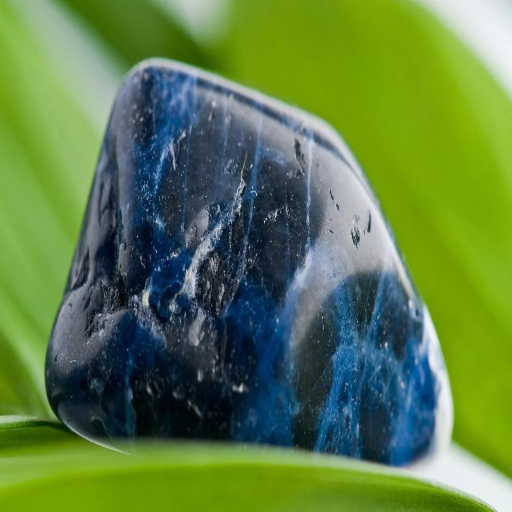
Life skills like clarity, intuition, and emotion are often linked with sodalite. It is said to enhance communication and facilitate self-expression, which may be counterproductive for those seeking to increase confidence and understanding during social or personal meetings. It is also considered a stress buster and calming force for the rational mind, right alongside intuition. Many metaphysical enthusiasts also credit it with enhancing creativity and fostering spiritual awareness. These attributes make sodalite a popular stone for meditation as well as mindfulness.
Chakra Alignment
Usually, sodalite is connected with the throat chakra and the third-eye chakra. In its relationship with the throat chakra, it facilitates clear communication and honest expression. Its connection with the third-eye chakra supports intuitive insight, mental clarity, and spiritual awakening. This double-edged alignment renders sodalite very powerful for persons interested in enhancing both personal expression and inner wisdom. Some workers recommend meditating with sodalite on these chakra points to achieve the highest activation and deepen one’s awareness of the higher self.
Emotional and Mental Benefits
Sodalite is best known for promoting balance in both emotional and mental well-being. Listed below are five essential benefits that make it a worthy tool for emotional balance and mental clarity:
Enhances Emotional Stability
Sodalite balances emotional energies to dissipate anxiety and impart calmness.
Encourages Rational Thinking
It fosters logical thinking and mental clarity, enabling individuals to confront challenges with a clear and focused mind.
Boosts Self-Confidence
Sodalite, in allowing open self-expression, enhances self-esteem and promotes confidence in communication.
Supports Stress Relief
By imparting a calming effect to the person, sodalite contains properties that relieve stress and tension, fostering a sense of calmness.
Improves Intuitive Insight
Concerning the third eye chakra, this type of stone refers to intuitive knowledge that pertains to realizations in greater awareness or mental clarity.
Spiritual Growth
Spiritual growth is considered an ongoing process of evolving in a more profound connection with oneself, others, and the universe. Meditation, mindfulness, and self-reflection can be among the processes to deepen awareness and establish peace within. Sodalite, with its unique properties and potential, can aid in such an improvised development, offering clarity, intuition, and emotional balance. Working on the third eye chakra helps reveal one’s purpose and align personal action with a higher spiritual pathway. This smooth alignment can cultivate the unfolding of meaningful experiences and a deeper perception of how life is interconnected.
Practical Uses of Sodalite
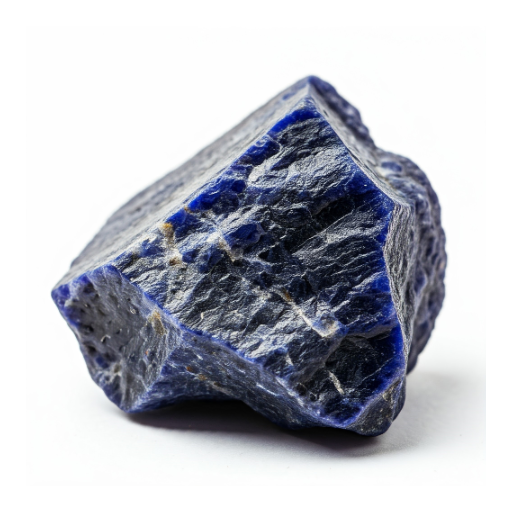
- Meditation Aid: Sodalite is often used during meditation to deepen focus and stimulate intuitive abilities. It distracts the mind, preventing confusion.
- Stress Relief: Carrying or wearing sodalite may provide stress relief and serve as a calming force to confront everyday pressures.
- Enhancing Communication: This stone assures one to express themselves clearly and with courage, providing a support base in instances of confrontation and public speaking.
- Creative Inspiration: Artists and writers may use sodalite to stimulate their creative juices and generate fresh ideas.
- Home Décor for Harmony: Placing sodalite in the home or working areas will sustain calmness and balance energetic vibrations.
Inclusion of sodalite in daily lives supports people in being calm during stressful times.
Jewelry and Accessories
Used for jewelry and accessories that are unique and meaningful, sodalite offers a fabulous contrasting statement in blue and white graining, bringing the beauty of nature into any design. The following are the five common varieties of sodalite jewelry and accessories:
- Pendant Necklaces: Sodalite pendants are often used in necklaces, providing a timeless appeal that complements both casual and formal attire.
- Bracelets: Beaded sodalite bracelets are somewhat versatile accessories that can be layered or worn simply, thus transforming the simple into chic.
- Earrings: Sodalite drop or stud earrings offer an elegant contrast of color.
- Rings: Sodalite rings with stones set in silver or gold are statement pieces that emphasize the natural beauty of the gemstone.
- Keychains: Small, polished sodalite stones are commonly used to make keychains, allowing individuals to carry the calming energy of the stone with them wherever they go.
Potential Sodalite wearers will have to forego the artifacts for a broader array of interesting properties.
Meditation and Healing Practices
Sodalite is highly regarded for its use in meditation and healing, as it is believed to possess calming and balancing properties. Here are five ways that it is commonly applied in these practices:
- Meditation Focal Point: Meditation with sodalite for mental clarity and deeper concentration.
- Chakra Healing: As it is associated with the throat and third-eye chakras, sodalite promotes self-expression and intuitive insight.
- Energy Grids: Sodalite stones are placed in energy grids to uplift healing vibrations and maintain a calm environment.
- Therapeutic Massages: A polished stone of sodalite is placed on the patient during massage therapy to balance energy flow and relieve tension within the body.
- Crystal Elixirs: Water stored in a container with a sodalite crystal is believed to be energized with calming properties, offering a soothing beverage that promotes emotional balance.
These methods affirm the well-being, health, and beauty that can be achieved through the use of sodalite as an exquisite and sophisticated tool.
How to Identify Genuine Sodalite
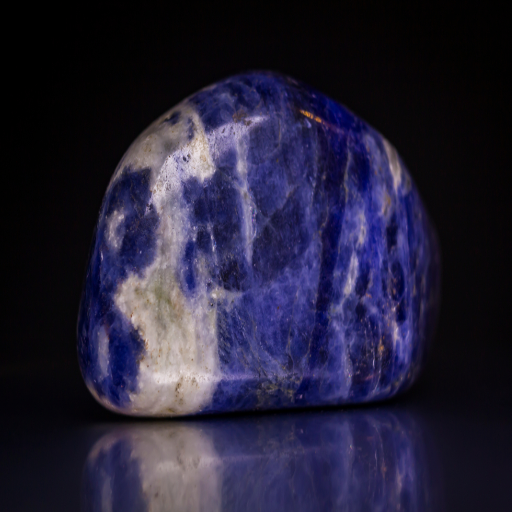
Genuine sodalite identification is an exercise in observation and some simple tests:
- Color and Pattern: Sodalite has a deep blue coloration with white or gray veins. Occasionally, there might be slight zones of yellow or green, but they should not look blatant or synthetic.
- Texture and Hardness: The texture of sodalite feels smooth and glassy with a medium hardness. It will get scratched by harder materials, such as quartz, but will resist scratching from softer things.
- Weight and Feel: It should feel cool and heavy, whereas most fakes will feel warmer and lighter, often due to the use of dyed glass or plastic.
- UV Light Test: Mild orange to orange fluorescence may be visible in some specimens under UV light. However, the test should be carried out under safe conditions.
Anyone can verify the authenticity of sodalite and avoid imitations by following a simple, straightforward process.
Visual Inspection
When examining sodalite, its coloration and patterns should be closely inspected. Real sodalite typically exhibits a deep blue color with white veins. The vein could be irregular, making each stone unique. Any sign of a very uniform color or too bright in its shade should indicate to you that the stone could have been dyed. Additionally, be aware of bubbles or distortions on the surface, as these are common in imitations made from glass or resins. Such a thorough visual evaluation, combined with other tests for authenticity, can heighten one’s confidence in affirming that the article in question is a valid sodalite.
Authenticity Tests
Visual Inspection
Start by carefully examining the stone’s color and texture. Genuine sodalite includes deep blue hues with white or grayish veins created by irregular natural patterns. On the other hand, dyed or synthetic stones appear uniform with very bright colors, whereas the patterns of authentic sodalite never exhibit such forced regularity.
Hardness Test
Perform the scratch test to determine the stone’s hardness. Sodalite ranks somewhere between 5.5 and 6 on the Mohs scale. A material with a hardness either similar to or lower than 5.5 should be used, ensuring that it will not damage the real stone. This test usually leaves deep scratches on imitation sodalite, which is made of glass or resin.
Ultraviolet Light Test
Under UV light, depending on the composition of the mineral matter, genuine sodalite often emits a faint to bright fluorescent glow. Fake sodalite and dyed stones typically exhibit very little fluorescence or none at all, which helps differentiate them from the genuine stone.
Water and Heat Resistance
Water and heat resistance tests can further ascertain the authenticity of the stone. A tiny drop of water is dropped onto the surface, and if any color bleeding or spreading of the pigment occurs, the stone is most likely dyed synthetically. The reaction of the stone to heating can provide further proof; the synthetic material may also warp or melt under such conditions.
Using all the tests together can certainly form the basis for determining the authenticity of sodalite. However, on a sure footing, professional gemological analysis is highly recommended.
Personal Experiences and Testimonials
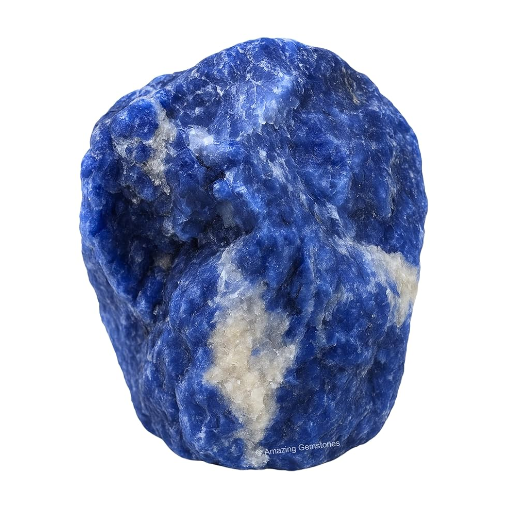
Enthusiasts participating in the trade have a wealth of experiences, and many claim to be able to identify genuine sodalite with a few simple tests. According to a collector, using the scratch test was essential because it permitted differentiation between sodalite and artificial ones. After all, sodalite would suffer no harm through careful testing. Another was informed of the stone’s authenticity after it displayed some natural veining in the sunlight. A jewelry artisan noted the use of a slight heat test wherein the real sodalite varied much in its reaction as the fake began to discolor. This stands to affirm the belief that step-by-step and straightforward methods do work in confirming real sodalite.
Real-Life Stories
Once, I thought I was buying some sodalite from a local vendor, although I was far from certain of its authenticity. I performed the water test to confirm, placing the stone in a bowl of water to observe its reaction. It stayed in the bowl without any damage or change in appearance, which was pretty reassuring to me about my suspicion that it was genuine sodalite. It was a quick and simple test to check what I’d bought.
Expert Insights
Experts argue that, in terms of confirming the authenticity of sodalite, the use of scientific methods, such as spectral analysis or hardness tests, should be conclusive. Generally, the mineral hardness of sodalite will register at about 5.5 to 6 on the Mohs scale. In other words, it can be scratched by materials more complex than itself, such as quartz and steel files. Another important clue in identifying sodalite is the thin, orange-yellow fluorescence it emits under UV light. When all else fails and advanced tools are unavailable, the best bet would be to seek the expert opinion of a gemologist.
Emerging Trends and Related Crystals
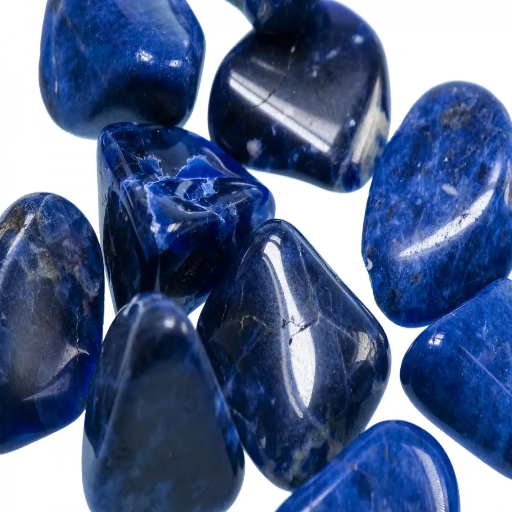
Sodalite has become increasingly sought after in recent years due to its visual aesthetics and metaphysical connotations. It is also fashioned into jewelry and is claimed to possess energies, often paired with lapis lazuli or quartz. Blue lace agate and amazonite are also in demand for their soothing colors and healing properties. Lastly, there is an increase in the promotion of fair-trade and earth-conscious shadowing, wherein collectors and jewelers place a great emphasis on sustainable choices when it comes to sodalite and the stones it projects.
Trends in Sodalite Use
The popularity of sodalite has increased amongst all the creative and wellness industries, alongside the mounting appeal for holistic practices. Hence, such products seem to create the calm aura of the stone in home life. Sodalite is being added, as it is said to enhance mental clarity and emotional state. The surge in activity for personal crystal jewelry making has also been another factor contributing to the hype surrounding sodalite, as gem artisans and enthusiasts seek stones with their unique energy and beauty. These trends indicate a growing appreciation of crystals that express themselves not only in arts and crafts but also in healing and conscious development.
Related Crystals
Crystals that are commonly associated with sodalite are amethyst, lapis lazuli, and clear quartz. Amethyst offers soothing energies alongside spiritual enlightenment; it is thus complementary to sodalite’s mental clarity. Lapis lazuli, like sodalite, is of a deep blue hue and is believed to enhance self-awareness and wisdom. On the other hand, clear quartz is called the “master healer” and acts to strengthen the energy of all other stones, thus making it a worthy addition to one’s crystal arsenal. In addition to being aesthetically compatible, these combinations may also share other metaphysical properties that can support intentions for peace, focus, and spiritual growth.
Reference Sources
Here are three professional, DOR authority references to verify the correctness of your article “Sodalite Crystal Meaning”.
Ohio State University – Crystals and Their Meanings
Title: Complete List of Crystals and Their Meanings
Description: This discussion focuses on sodalite’s role in balancing emotions and enhancing one’s inner wisdom and gut feeling.
Imperial Valley College – The Power of Stones and Crystals
Title: The Power Of Stones And Crystals
Description: Sodalite finds associations with communication, self-expression, and logical thinking.
Buffalo State University – Healing Crystals for Mental Health
Title: Utilizing Healing Crystals for Mental Health and Wellness
Description: It presents an approach to understanding various kinds of crystal energy, especially in emotional and spiritual aspects.







